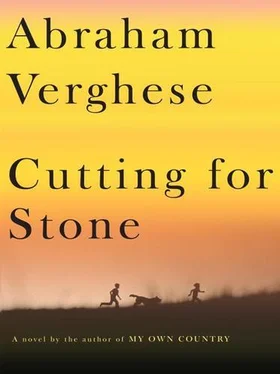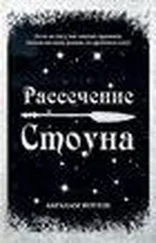As I carried her daughter into our house through the kitchen, Rosina watched from her doorway. Genet never looked in that direction. It was as if her mother and the room in which she had lived her life no longer existed. Rosina stood there, beseeching with her eyes, pleading for forgiveness. But a child's ability for reprisal is infinite, and can last a lifetime.
I carried Genet to our old room, Shiva's room, which would now be hers.
The plan was that Shiva and I would sleep in Ghosh's old quarters, but separately, he in the living room.
Half an hour later, when I went to get Genet's clothes from Rosina's quarters, she had locked herself in and wouldn't answer despite my knocking. I pushed on the wood in anger, and I could tell from the resistance that she'd barricaded the door or else she was leaning against it. A peculiar silence blanketed the atmosphere. I went to the window. The shutters were bolted, but now, with Almaz helping, I pulled on the flimsy slats till they snapped off. The wardrobe had been used to block the window. I scrambled onto the ledge and tried to shove the wardrobe aside with my hands, but I couldn't. I craned my neck to peer above it. What I saw made me set my back to the window frame, put both feet on the wardrobe, and topple it without a thought to its contents. It hit the ground with a terrific crash, the wood splintering, the mirror shattering, plates smashing. It brought everyone running.
I could see clearly now. We all could see. Hema, Ghosh, Shiva were behind me, and even Genet, hearing the commotion, had dragged herself there.
There is a mathematical precision to that scene as I remember it, but there are no angles in Carr's Geometry or any other text that quite describe the slant of that neck. And no pill in the pharmacopoeia that might erase the memory. Hanging from a rafter, her head tilted on her spine, her mouth open and the tongue looking as if it had been yanked out of her throat, was Rosina.
35. One Fever from Another
THE MOSSY STONE WALLS and the massive gate of Empress Menen School gave it the look of an ancient fortress. In her white socks, light blue blouse, dark blue skirt, and with no headbands, clips, or earrings, Genet was just one of the girls, blending in. Her only adornment was the St. Bridget's cross hanging from her neck. She didn't want to stand out. Her old vivacious self had died along with the corpse we took down from the rafter and buried in Gulele Cemetery.
My new ritual was to come on Saturday evenings to see Genet. She was just up the hill from the palace where General Mebratu (with Zemui at his side) took hostages and tried to bring about a new order.
Genet could have come home on weekends, but she said Missing evoked painful memories. She insisted she was happy at Empress Menen. The Indian teachers were strict but very good. Sheltered from society and from us, she worked very hard.
We entered university together for our premedical course, and the following year we entered medical school. Now out of uniform and in regular clothes, her dress and manner remained reserved and subdued. Each time I went to visit Genet in the Mekane Yesus Hostel opposite the university, I'd pray that this would be the day when the locked door to her heart opened and I might see traces of the old Genet. She was appreciative for the tiffin carrier of food Almaz and Hema sent for her, but the barrier she put up around herself remained.
I still loved her.
I wished I didn't.
We entered the Haile Selassie the First School of Medicine in 1974— only the third class to be admitted. Genet and I were paired as dissection partners on a cadaver, which was fortunate for her. Anyone else would have taken offense at her frequent absences and her failing to carry her load. I didn't think she was lazy. There was no good reason for this; something was brewing, and for once I had no clue.
OUR BASIC SCIENCE TEACHERS were very good, a mix of British and Swiss professors and a few Ethiopian physicians who graduated from the American University of Beirut and then took postgraduate training in England or America. There was one Indian: our own Ghosh. Ghosh had a title: not Assistant Professor, or Associate Professor, or Clinical Associate Professor (implying an honorary, unpaid designation), but Professor of Medicine and Adjunct Professor of Surgery.
I don't think any of us, not even Hema, realized the extent of Ghosh's scholarship during his twenty-eight years in Ethiopia. But Sir Ian Hill, dean of the new medical school, certainly did. Ghosh had forty-one published papers and a textbook chapter to his name. An initial interest in sexually transmitted illness had given way to major scholarship on relapsing fever, for which he was the world's expert, because the louse-borne variety of this disease was endemic to Ethiopia, and because no living person had observed the disease as closely.
I learned about relapsing fever as a schoolboy when Ali of the souk opposite Missing brought his brother, Saleem, to the hospital and asked me to intercede. Saleem burned with fever and was delirious. Ghosh said later that Saleem's story was typical: He'd arrived in Addis Ababa from his village with his life's belongings in a cloth strung over his shoulder. Ali found his brother a toehold in the seething, swarming docks of the Merkato, where, monsoon or not, he hauled sacks off the trucks and into the godowns. At night he slept cheek by jowl with ten others in a flophouse. In the rainy season, there was little opportunity to wash clothes because they would take days to dry. Saleem's living conditions were unfit for humans, but ideal for lice. While scratching his skin he must have crushed a louse, its blood entering his body through the scratch. Coming from the village, he had no immunity to this urban disease.
In Casualty, Saleem lay on the ground too weak to sit or stand, semiconscious. Adam, our one-eyed compounder, bent over the patient, and with one swift move made the diagnosis.
Years later Ghosh showed me the correspondence he had with the editor of the New England Journal of Medicine, who was about to publish Ghosh's seminal series of cases of relapsing fever. The editor felt “Adam's sign” was pretentious. Ghosh defended the honor of his uneducated compounder at the risk of not being published in that prestigious journal.
Dear Dr. Giles,
… in Ethiopia we classify hernias as “below the knee” and “above the knee,” not “direct” or “indirect.” It's another order of magnitude, sir. Our casualty room often has as many as five patients prostrate on the floor with fever. The clinician asks: Is this malaria? Is it typhoid? Or is it relapsing fever? There is no rash to help sort this out (the “rose spots” of typhoid are invisible in our population), though I will grant you that typhoid causes a bronchitis and a slow pulse, and people with malaria often have giant spleens. I would be remiss in publishing a paper on relapsing fever without providing the clinician a practical way to make the diagnosis, particularly in settings where blood and serum tests are hard to come by. The clinician has only to grab the patient's thigh, squeeze the quadriceps muscle, squeeze it hard: Patients with relapsing fever will jump up because of the otherwise silent muscle inflammation and tenderness that is part of this disease. Not only is this a good diagnostic sign, but it can raise Lazarus. This sign was first noted by Adam, and is deserving of the eponym “Adam's sign.”
I could testify to Adam's sign—Saleem yelled and leaped to his feet when Adam mashed. The editor wrote back. He was pleased with all the other revisions but Adam's sign remained a sticking point. Ghosh held his ground.
Dear Dr. Giles,
… there is a Chvostek's sign, a Boas's sign, a Courvoisier's sign, a Quincke's sign—no limit it seems to white men naming things after themselves. Surely, the world is ready for an eponym honoring a humble compounder who has seen more relapsing fever with one eye than you or I will ever see with two.
Читать дальше












